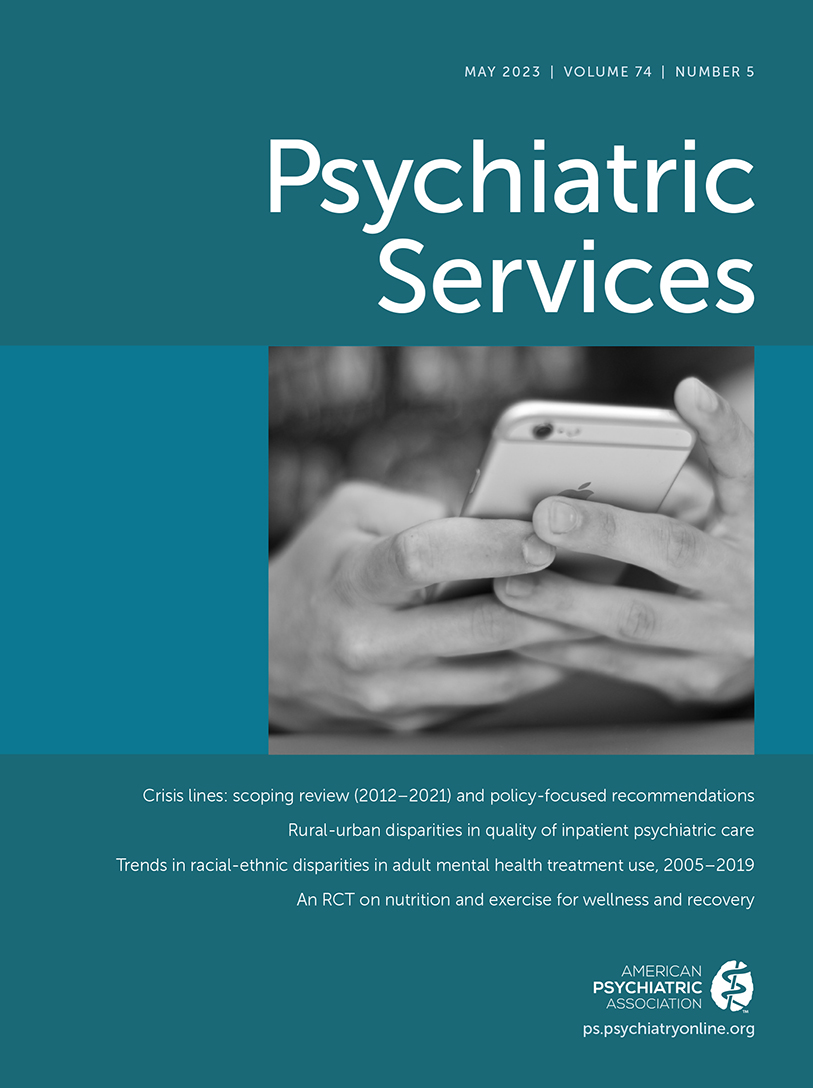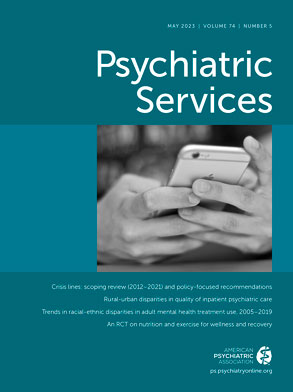The prevalence of hearing loss (HL) in the general population rises steeply with age, from 3% among adults ages 20–29 years, to 49% of adults ages 60–69, to >80% among those >85 years (
1). HL is associated with adverse cognitive, mental, and general medical health outcomes, including cognitive impairment and accelerated cognitive decline (
2,
3), social isolation and depression (
4,
5), and frailty and falls (
6). Among people with schizophrenia and other serious psychiatric diagnoses, additional health conditions are often missed or unrecognized because of a multitude of factors, including, but not limited to, inequitable access to routine screening and health care, fragmented general medical and mental health services, and diagnostic overshadowing (
7,
8). Schizophrenia is itself associated with significant cognitive, social, and functional disability across the life span (
9), as well as elevated risk for a dementia diagnosis beginning near the fifth decade of life (
10). Because HL is a modifiable but potentially undetected source of disability, it is important to gauge the prevalence and understand the nature of HL among adults with a schizophrenia diagnosis. Doing so may help better prepare behavioral health practitioners to provide adequate, age-appropriate services, including routine screening, evaluation, and treatments that will promote healthy aging and preserve quality of life.
Hearing impairment, congenital or acquired, has previously been linked to the development of psychotic symptoms (e.g., hallucinations and delusions) or “states” (
11). However, the epidemiological literature on hearing impairment specific to people with a history of schizophrenia is limited. For example, one population-based survey of HL conducted in Finland (
12) reported elevated prevalence rates of HL among persons diagnosed as having a psychotic disorder (10.5%–14.4%), or schizophrenia diagnosis specifically (13.7%), compared with the general population (11.6%), although the differences were not statistically significant. However, the findings also suggested elevated hearing thresholds, increased self-reported hearing impairment, and differential rates of impairment with increasing age, with elevated HL rates being evident among those diagnosed as having schizophrenia and ages ≥65 (
12).
The frequency and severity of clinically defined HL among people with schizophrenia have otherwise not been well characterized. Thus, the purpose of this study was to reexamine HL in a larger sample of people with schizophrenia by addressing two specific questions: How do audiometric hearing thresholds compare between age-matched community-dwelling adults with and without a diagnosis of schizophrenia? Do people with schizophrenia show elevated rates of HL relative to participants in a comparison group without the condition and matched by age?
Methods
This study was a secondary analysis of deidentified cross-sectional data. Data were extracted from an institutional review board (IRB)–approved observational cohort study (ClinicalTrials.gov identifier: NCT04025502), designed to capture normative electrophysiological (electroencephalography and event-related potential [EEG/ERP]) and psychometric measures in adults with and adults without a diagnosis of schizophrenia. All participants were community members recruited in the United States through local advertisements or physician referrals and gave informed consent for research. All eligible participants were ages 21–50 years, fluent in English, and in otherwise good stable health without intellectual disability, illicit substance use, neurological illness, injury, or other condition (e.g., known sensory impairment) that would affect the ability to undergo the study assessments.
Participants with a clinical DSM-5 diagnosis of schizophrenia (N=84), confirmed with the Mini International Neuropsychiatric Interview (MINI), were evaluated for inclusion via their medical records to verify an illness duration of ≥1 year (mean±SD=14.8±7.9), with no recent hospitalizations for acute psychosis and on a stable regimen of antipsychotic medications for ≥6 weeks. All participants with a diagnosis of schizophrenia received a prescription of up to two first- or second-generation antipsychotic medications permitted for study inclusion. Participants in the age-matched comparison group (N=81) had neither current evidence or history of psychiatric illness as determined by the MINI nor a biological family history of schizophrenia spectrum disorders in a first- or second-degree relative. Audiometry data were collected between October 2019 and December 2021.
Audiometry was performed as a part of eligibility screening for electrophysiology assessments, using a portable general-purpose EEG/ERP system (COGNISION) with medical-grade insert earphones. After the EEG/ERP headset was applied, a series of short-duration 1,000-Hz tones was played at 40 decibels (dB); participants were instructed to press a button whenever they heard a tone in either ear. If a button press indicated the sound was heard, the volume was decreased by 10 dB. If no button was pressed, the volume was increased by 5 dB. Real-time and off-line quality-control checks ensured protocol adherence and data validity. Hearing threshold was defined separately for each ear as the lowest detectable pure tone, with higher dB thresholds indicating worse hearing (range 0–80 dB). By convention, when performance differed between the two ears, the better ear was used to characterize the hearing threshold as a continuous measure and to identify individuals with mild HL (i.e., whose hearing threshold was above 25–40 dB).
As a secondary analysis of deidentified data, this study was exempt from IRB review. We first compared the demographic characteristics of the two study samples with t tests and chi-square tests for continuous and categorical data, respectively. To answer the first study question, we characterized the hearing threshold in the better ear by using descriptive statistics for each group and compared differences between the groups with analysis of variance. For the second question, we compared the proportion of participants with mild HL between groups by using Fisher’s exact test. For descriptive analyses, within-group HL rates were identified per age decade.
Results
Participants with schizophrenia did not significantly differ from participants in the comparison group with respect to sex and racial or ethnic identification. (Demographic characteristics by group and results of statistical analyses are presented in the online supplement to this report.) The mean±SD age of the total sample (N=165) was 37.9±8.8 years, 59% (N=97) were male, and most self-identified as non-Hispanic/non-Latinx (73%, N=121). The total sample included individuals who self-identified as White/Caucasian (18%, N=29), Black/African American (47%, N=78), Asian (9%, N=15), more than one race (4%, N=6), or other (2%, N=3) or did not state their race (21%, N=34). The mean hearing threshold at 1,000 Hz among participants with schizophrenia was 17.4±8.3 dB, which was significantly higher than the hearing threshold of 14.1±6.4 dB in the comparison group (F=7.81, df=1 and 163, p=0.006, effect size [ηp2]=0.046).
Because increasing age was significantly associated with higher hearing thresholds (r=0.31, p<0.001), with no significant differences in hearing threshold by sex or racial or ethnic group, we conducted a follow-up analysis of covariance to examine the group difference in hearing threshold, controlling only for age as a continuous variable; the difference remained statistically significant (F=6.87, df=1 and 162, p=0.01, η
p2=0.041). Overall, a significantly larger proportion of participants with schizophrenia (24%) had mild HL compared with comparison participants (6%) (p=0.002) (
Table 1). This finding was observed across all age decades, although small subsample sizes precluded assessing the statistical significance of any differences. No participants from either sample were classified as showing moderate or severe HL on the basis of data from the better ear.
Discussion
This study brings attention to hearing impairment as a condition of significant clinical and public health relevance for people with schizophrenia. We found that hearing thresholds quantified by pure-tone audiometry revealed both significantly poorer hearing and higher rates of mild HL in adults ages 21–50 years with a history of schizophrenia relative to age-matched adults without schizophrenia. The frequency of HL increased with age in both groups as expected, but the proportion of individuals with schizophrenia affected by mild HL was significantly higher and was observed across the different age groups and even in younger participants. Notably, the presence of hearing impairment among the study participants was not previously known, and none had hearing aids, which are indicated for mild HL.
Thus, these results suggest the importance of screening for hearing impairment in adults with schizophrenia and doing so at ages younger than when clinically defined age-related HL might be expected to be present on the basis of general population data (
1). The reasons for the elevated HL rates among people with schizophrenia observed here are unclear but may be related to the multitude of comorbid conditions that are known risk factors for age-related HL and are also prevalent in this population (
13), such as diabetes, hypertension and cardiovascular disease, cerebrovascular disease, and cigarette smoking (
14).
Methodological strengths of this study were the moderate to large sample sizes, diagnostic specificity, use of an age-matched comparison group, and use of pure-tone audiometry, a standardized objective measure of hearing ability. Although clinician observation of hearing deficit or self-report of hearing ability, for example, perceived ability to hear in conversation and in a noisy environment, may yield clinically useful information, both are subject to information biases. In the absence of routine objective screening, existing impairment may continue to go unnoticed or may be misattributed and undiagnosed. Portable audiometry systems hold promise for creating scalable protocols for evaluating hearing in community clinic settings, where individuals with schizophrenia may be more likely to receive comprehensive health services. A second study is currently underway that examines the feasibility of conducting audiometry screening in the clinical setting, outside a controlled research environment. Furthermore, rising interest in HL as a potentially modifiable risk factor for mood and neurocognitive disorders has led to the passage of the Over-the-Counter Hearing Aid Act (
15), which may greatly improve the accessibility of HL treatment.
Future investigations might seek to overcome the limitations of this study’s design. First, the audiometry assessment tested hearing threshold at only one frequency (1,000 Hz). Studies aiming to understand the functional implications of hearing impairment and loss should employ frequencies across the critical range of human speech (0.5–4,000 Hz). Second, the study was limited to individuals fluent in English; it will be important to determine whether language or cultural differences influence receptivity or present practical difficulties that should be addressed to allow for routine hearing testing. Third, this study was limited by the upper limit on the age range of its participants. Because HL rates increase with age, it will be important to include sufficient numbers of older adults to allow for meaningful analysis by age decade and comparison with published epidemiological data. Improving our understanding of HL across the life span among people with schizophrenia may elucidate new mechanisms of cognitive and psychosocial functioning and inform service needs to better address health and quality of life.
Conclusions
Evaluating the relationship among audiological, cognitive, and psychosocial functioning among people with schizophrenia is a logical next step in understanding the significance of our findings. However, these results have immediate implications for behavioral health providers serving adults with a schizophrenia diagnosis—that is, providers should ask themselves, Is this person really hearing me?
Acknowledgments
Deidentified data for the analyses presented in this report were provided by the ERP Biomarker Qualification Consortium.

